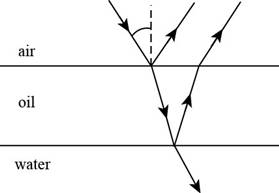
Concept explainers
(a)
The wavelength and the color of the light in the visible spectrum most strongly reflected.
(a)
Answer to Problem 22P
The value of
Explanation of Solution
Given Information: The refractive index of the oil film is
It is given that an oil film floating on water is illuminated by white light at normal incidence as shown in figure given below.

Figure (1)
For most strongly reflected waves:
Write the expression for the constructive interference in thin film.
Here,
From equation (1), formula to calculate the value of wavelength of the light is,
From equation (2), formula to calculate the value of wavelength of the light for
Here,
Substitute
The range for the wavelength of the visible light is
Thus, the value of wavelength of the light for
From equation (2), formula to calculate the value of wavelength of the light for
Here,
Substitute
Thus, the value of wavelength of the light for
From equation (2), formula to calculate the value of wavelength of the light for
Here,
Substitute
Thus, the value of wavelength of the light for
Conclusion:
Therefore, the value of wavelength of the light for
(b)
The wavelength and the color of the light in the spectrum most strongly transmitted.
(b)
Answer to Problem 22P
The value of wavelength of the light for
Explanation of Solution
Given Information: The refractive index of the oil film is
For most strongly transmitted waves:
Write the expression for the destructive interference in thin film.
From equation (5), formula to calculate the value of wavelength of the light is,
From equation (6), formula to calculate the value of wavelength of the light for
Here,
Substitute
Thus, the value of wavelength of the light for
From equation (6), formula to calculate the value of wavelength of the light for
Here,
Substitute
Thus, the value of wavelength of the light for
From equation (6), formula to calculate the value of wavelength of the light for
Here,
Substitute
Thus, the value of wavelength of the light for
Conclusion:
Therefore, the value of wavelength of the light for
Want to see more full solutions like this?
Chapter 36 Solutions
Physics for Scientists and Engineers with Modern Physics
- Is work function of a metals surface related to surface energy and surface tension? What is the need to the work function component in the math of tension of metal surfaces that cannot be provided by existing equations of surface energy and surface tension? What are the key differences in each parameter and variables that allow for a differentiation of each function? What has a more significant meaning work function, surface tension or surface energy? Are there real differences and meaning? Please clarify and if possible provide examples . Does surface tension dependant on thickness of a metal or type of metal surface all having the same thickness? Clearly temperature has a profound change on surface tension what other variables besides temperature are key to surface tension. What if any is there a connection between crystal structure of the element and surface energy and tension? This is NOT a Assignment Question!!!arrow_forwardThe cylindrical beam of a 12.7-mW laser is 0.920 cm in diameter. What is the rms value of the electric field? V/marrow_forwardConsider a rubber rod that has been rubbed with fur to give the rod a net negative charge, and a glass rod that has been rubbed with silk to give it a net positive charge. After being charged by contact by the fur and silk...? a. Both rods have less mass b. the rubber rod has more mass and the glass rod has less mass c. both rods have more mass d. the masses of both rods are unchanged e. the rubber rod has less mass and the glass rod has mroe massarrow_forward
 Physics for Scientists and Engineers with Modern ...PhysicsISBN:9781337553292Author:Raymond A. Serway, John W. JewettPublisher:Cengage Learning
Physics for Scientists and Engineers with Modern ...PhysicsISBN:9781337553292Author:Raymond A. Serway, John W. JewettPublisher:Cengage Learning Physics for Scientists and EngineersPhysicsISBN:9781337553278Author:Raymond A. Serway, John W. JewettPublisher:Cengage Learning
Physics for Scientists and EngineersPhysicsISBN:9781337553278Author:Raymond A. Serway, John W. JewettPublisher:Cengage Learning University Physics Volume 3PhysicsISBN:9781938168185Author:William Moebs, Jeff SannyPublisher:OpenStax
University Physics Volume 3PhysicsISBN:9781938168185Author:William Moebs, Jeff SannyPublisher:OpenStax Principles of Physics: A Calculus-Based TextPhysicsISBN:9781133104261Author:Raymond A. Serway, John W. JewettPublisher:Cengage Learning
Principles of Physics: A Calculus-Based TextPhysicsISBN:9781133104261Author:Raymond A. Serway, John W. JewettPublisher:Cengage Learning College PhysicsPhysicsISBN:9781285737027Author:Raymond A. Serway, Chris VuillePublisher:Cengage Learning
College PhysicsPhysicsISBN:9781285737027Author:Raymond A. Serway, Chris VuillePublisher:Cengage Learning Physics for Scientists and Engineers, Technology ...PhysicsISBN:9781305116399Author:Raymond A. Serway, John W. JewettPublisher:Cengage Learning
Physics for Scientists and Engineers, Technology ...PhysicsISBN:9781305116399Author:Raymond A. Serway, John W. JewettPublisher:Cengage Learning





